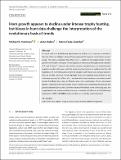Files in this item
Horn growth appears to decline under intense trophy hunting, but biases in hunt data challenge the interpretation of the evolutionary basis of trends
Item metadata
| dc.contributor.author | Morrissey, Michael B. | |
| dc.contributor.author | Hubbs, Anne | |
| dc.contributor.author | Festa‐Bianchet, Marco | |
| dc.date.accessioned | 2021-05-11T11:30:15Z | |
| dc.date.available | 2021-05-11T11:30:15Z | |
| dc.date.issued | 2021-05-05 | |
| dc.identifier | 274091124 | |
| dc.identifier | 702fd818-23b7-4f11-a5d8-53aab1113b15 | |
| dc.identifier | 85105055683 | |
| dc.identifier | 000647179300001 | |
| dc.identifier.citation | Morrissey , M B , Hubbs , A & Festa‐Bianchet , M 2021 , ' Horn growth appears to decline under intense trophy hunting, but biases in hunt data challenge the interpretation of the evolutionary basis of trends ' , Evolutionary Applications , vol. Early View . https://doi.org/10.1111/eva.13207 | en |
| dc.identifier.issn | 1752-4571 | |
| dc.identifier.other | Jisc: de03ac54be73400aaf92c012319477af | |
| dc.identifier.other | publisher-id: eva13207 | |
| dc.identifier.uri | https://hdl.handle.net/10023/23157 | |
| dc.description | Funding: MBM is supported by a University Research Fellowship from the Royal Society (London). M.F.‐B. is supported by NSERC. | en |
| dc.description.abstract | A recent article in Evolutionary Applications by LaSharr et al. reports on trends in the size of horns of bighorn sheep (Ovis canadensis) throughout much of the species’ range. The article concludes that there are “... stable or increasing trends in horn growth over nearly 3 decades in the majority of hunt areas throughout the western U.S. and Canada.” However, the article equates nonsignificance of predominantly negative trends in the areas with the most selective harvest as evidence for the null hypothesis of no trends and also fails to consider well‐known and serious biases in the use of data collected in size‐regulated hunts. By applying meta‐analysis to the estimates reported by LaSharr et al., we show that there has been a pervasive overall trend of declining horn sizes in Alberta, where the combination of horn size‐based legality, combined with unrestricted hunter numbers are understood to generate the greatest selective pressures. Given the nature of the biases in the underlying data, the magnitudes of the trends resulting from our re‐analysis of LaSharr et al.'s (Evolutionary Applications, 2019, 12, 1823) trend estimates are probably underestimated. | |
| dc.format.extent | 622285 | |
| dc.language.iso | eng | |
| dc.relation.ispartof | Evolutionary Applications | en |
| dc.subject | Wildlife Management | en |
| dc.subject | Artificial selection | en |
| dc.subject | Bighorn sheep | en |
| dc.subject | Evolution | en |
| dc.subject | Trophy hunting | en |
| dc.subject | GF Human ecology. Anthropogeography | en |
| dc.subject | QH301 Biology | en |
| dc.subject | 3rd-DAS | en |
| dc.subject.lcc | GF | en |
| dc.subject.lcc | QH301 | en |
| dc.title | Horn growth appears to decline under intense trophy hunting, but biases in hunt data challenge the interpretation of the evolutionary basis of trends | en |
| dc.type | Journal article | en |
| dc.contributor.sponsor | The Royal Society | en |
| dc.contributor.institution | University of St Andrews. School of Biology | en |
| dc.contributor.institution | University of St Andrews. Centre for Biological Diversity | en |
| dc.contributor.institution | University of St Andrews. St Andrews Bioinformatics Unit | en |
| dc.identifier.doi | 10.1111/eva.13207 | |
| dc.description.status | Peer reviewed | en |
| dc.identifier.grantnumber | IES\R3\203178 | en |
This item appears in the following Collection(s)
Items in the St Andrews Research Repository are protected by copyright, with all rights reserved, unless otherwise indicated.

